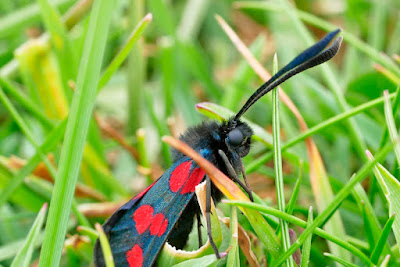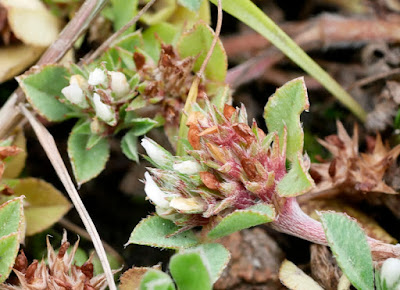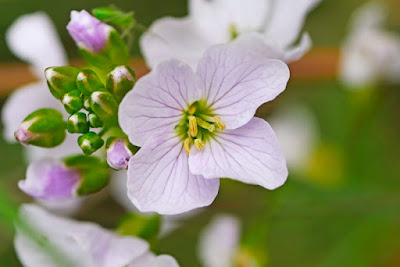As June comes to an end, the wildflowers keep on coming. Here's the best of what I found in the last week of so of June.
A road verge in a completely rural area provided me with this Orange Day Lily, a species I'd not seen before. It no doubt originated from old fly tipped material, though there was no evidence left and no other alien plants, gardens or habitation nearby. I researched this and found it to be a commonly found naturalised plant in Cornwall. Without the flower present the leaves look remarkably similar to Montbretia, so this may go un-noticed as a result.
Hemerocallis fulva
I found the dead stems of Pale Galingale in a roadside disused quarry in early Spring, so I returned to hopefully see them in flower. I wasn't disappointed and I can see why one of the common names is Umbrella Plant!
Cyperus eragrostis
This same quarry had loads of Spear-leaved Fluellen around the chippings on the track there. The flowers were tiny, but beautiful.
Kickxia elatine
In the same area was a Balm-leaved Figwort, another first for me. This is apparently native in Cornwall, but absent in much of the UK. The flowers are like any other Figwort, but the leaves are a different shape and look crumpled up.
Scrophularia scorodonia
Tregoss Moor was visited to see what I could find. It had the usual but amazing array of bog plants, however, it also included hundreds of Marsh Cinquefoils.
Comarum palustre
There was a huge hybrid swarm of orchids along a path by a railway line, interspersed with both parents, which were Heath Spotted and Southern Marsh Orchids. These contain a number of morphological features from both parents and are often (but not always) double the height (or more) of its parents too.
Dactylorhiza x hallii
The impressive and large Royal Ferns were abundant on the Moors too. The fruiting frond is quite unmistakable as shown below as no other UK fern looks remotely similar.
Osmundia regalis
An exciting find on the edge of the bog were several clumps of Ivy-leaved Bellflowers. I'd only seen these once before at Sissinghurst in Kent. However from reveiwing previous records for it, I can see they are more common in Cornwall on the bogs and moors. The flowers are quite small and usually you see the odd looking leaves first.
Wahlenbergia hederacea
Not all roses are Dog Roses. This rose below, is Sherards Downy Rose, which has lots of glands under the flowers and on stalks. When rubbed these smell a bit rank, like a resin. They are called Downy Roses as the leaf undersides are hairy to some extent. On this plant the leaf veins were hairy and the flower stalks short, telling it apart from the Harsh Downy Rose.
Rosa sherardii
A quite different habitat to Cornwall's bogs and moors are the calcareous dunes on the north coast. As such, different flowers can be found such as these Pyramidal Orchids in a sandy car park at Trevone. In 2012 just 6 spikes were recorded here, however, there were easily over 100 now, so it's doing well here.
Anacamptis pyramidalis
As June comes to an end, the Summer wildflowers are coming into full bloom. Also at Trevone was this lovely stand of Greater Scabious growing on top of a Cornish wall.
Centaurea scabiosa
In the last few days of June, I visited another disused quarry, this time not that far from Wadebridge. I was surprised to find numerous bushes of Himalayan Honeysuckle with their unique flowers. I guess some were originally planted, but they have seeded over a wide area by themselves now.
Leycesteria formosa
Betony is now in flower. A plant of Cornish walls, road verges and in abundant numbers on some areas of coastal turf. This plant was doing very well at Carnewas, managed by the National Trust. The other flower spike belonging to Sea Plantain.
Betonica officinalis and Plantago maritimum
More Betony flowering with Wild Carrot.
Betonica officinalis and Daucus carota (ssp gummifer)
Outside the NT cafe at Carnewas (also known as Bedruthan Steps) were two sea spurries growing side by side. This gave me an excellent opportunity to see the differences between them easily. The large flowered plant by the wall is Rock Sea-Spurrey and the tiny flowered plant in the foreground is Greek Sea-Spurrey with woody stems at the base.
A close up photo of Rock Sea-Spurrey
Spergularia rupicola
And Greek Sea-Spurrey, note the smaller petals in comparison to the sepals underneath. The woody stems and dense glandular hairs all over, seperate it further from Lesser Sea-Spurrey.
Spergularia bocconei
So ended June, I hope you liked the wildflowers featured. Of course, there were lots more that I photographed, but ran out of time and space to include them. What will I find in July I wonder. One thing for sure that I will find is heat and drought!
Take care
Dave














































































